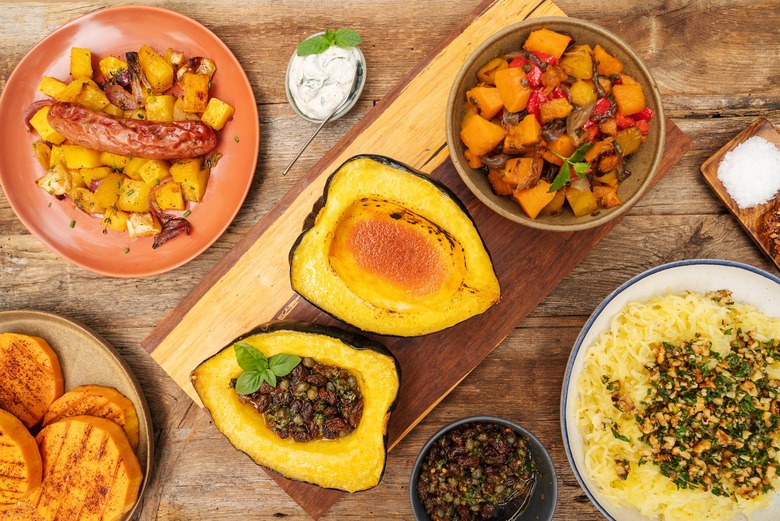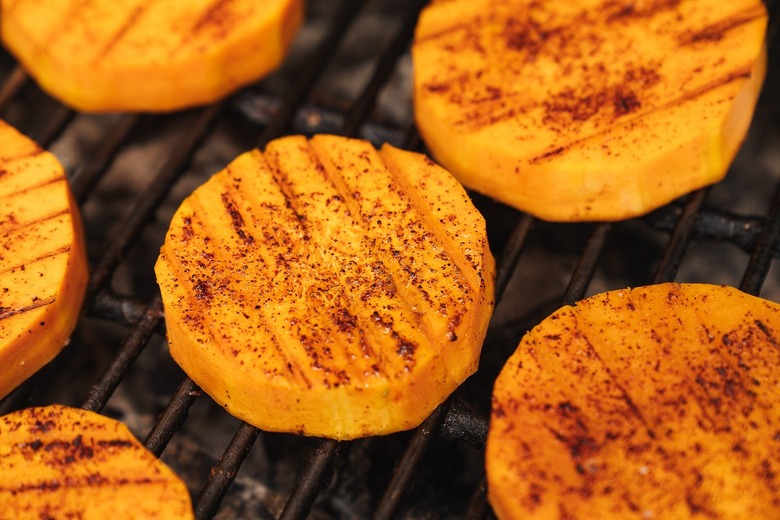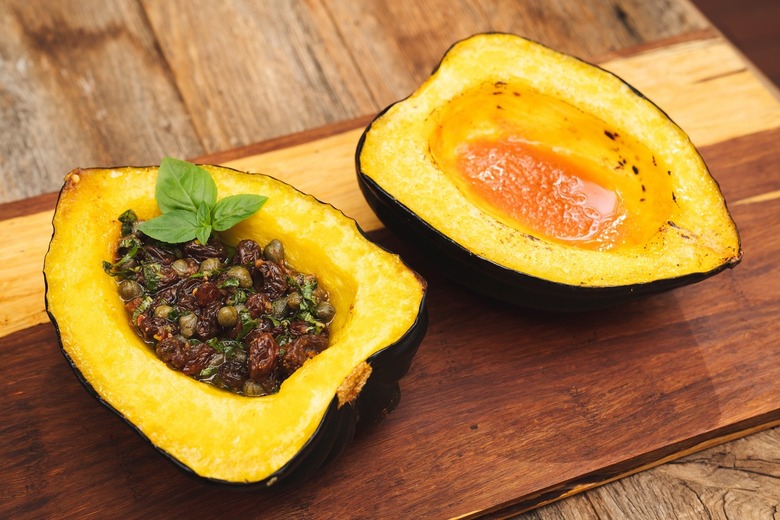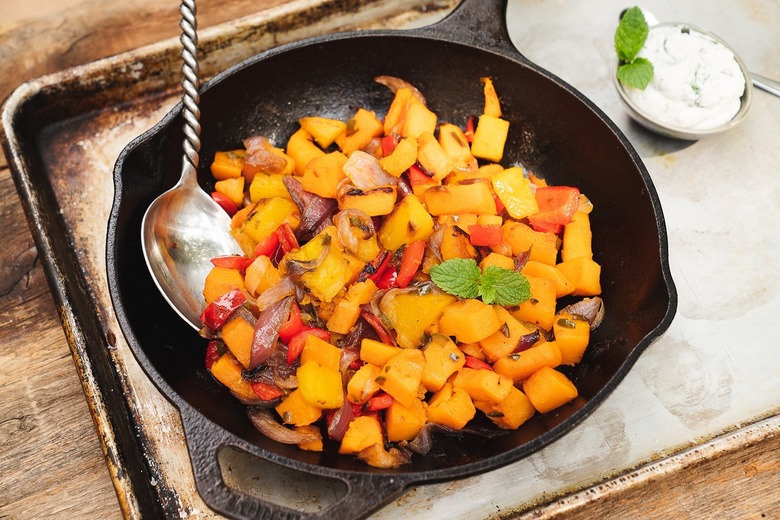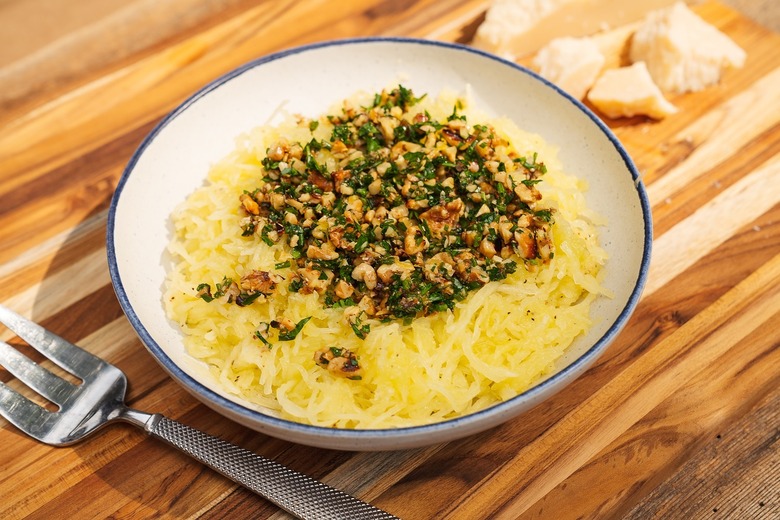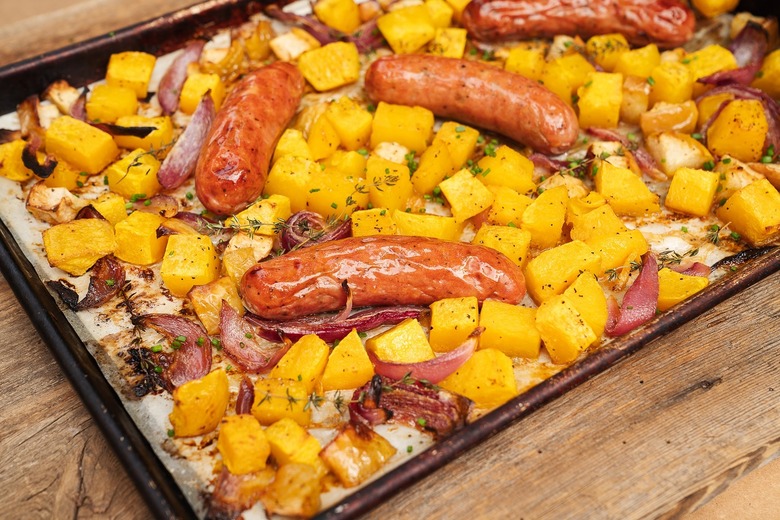Everything You Need To Know To About Cooking Winter Squash, Plus 5 Recipes
All summer, we enjoy our share of zucchini and summer squashes. Come autumn, we happily embrace their harder-shelled, densely-fleshed, sweet-tasting brethren. Like summer squash, mild-tasting winter squash welcomes bold flavor additions. Unlike summer squash, most winter squash varieties keep well for weeks, sometimes months, so fans can stock up at local farmers markets and produce stands.
Month-to-Month Seasonal Produce Guide
There are dozens and dozens of squash varieties; it's worth your time to get to know them. Acorn squash has long been an American staple, but it's certainly not the most interesting flavor-wise. Three favorites — butternut, spaghetti squash and kabocha—can be found readily in large grocery stores. More exotic renditions, such as buttercup, red kuri, Hubbard and delicata, show up at farmers markets in early fall.
No matter what kind of squash you decide to try, select a squash that is heavy, rock hard and free of blemishes. When possible, choose squashes with their stems attached — these will keep the longest.
Once purchased, you'll need to address peeling and cutting the squash. Not all squashes need to be peeled, but if they do, peel using a vegetable peeler, then switch to a paring knife to trim any stubborn bits before cubing.
If you are not peeling your squash, be careful! Cutting through the tough skin requires a sharp knife and some pressure. Make sure your cutting board is stable and keep your eyes on the knife. Cut the squash in half, then scoop out the seeds with a spoon. Set the cut side down to slice into wedges or smaller pieces. Enlist help to cut up the squash. The reward is delicious!
After the squash is peeled, cut or sliced, you can keep it in the refrigerator for three to five days. This makes weekday squash cooking doable for time-pressured cooks. You can freeze raw diced squash on a baking sheet until solid. Then scoop the frozen pieces into a freezer-safe bag and freeze for up to six months, so you can make fresh squash soups, stews and braises all year long. Cooked squash also keeps well in the refrigerator and can be frozen.
The flesh isn't the only edible part of squash; the seeds can be rinsed, salted and slow-roasted in a 200F oven, stirring often, for an hour or more, until crispy. They work great as a healthy desk snack or a crunchy addition to salads.
Note that most winter squash varieties are interchangeable in recipes with some subtle changes in flavor, though their yields will vary thusly:
-
Kabocha: A 2 1/4-pound squash, peeled and seeded, yields 6 cups of cubes (about 2 pounds)
-
Butternut: A 3-pound squash yields 3-4 cups of peeled cubes from bulbs and 1 1/4 pound of peeled round slabs from the neck
-
Spaghetti squash: A 3-pound squash yields 4 generous cups of shredded cooked flesh (about 1 pound 14 ounces)
Now that you are armed with the knowledge of how to cook squash, test your skills with these five recipes.
Grilled Butternut Rounds
Butternut squash is the gift that keeps on giving. I cut the bulbous end into cubes for roasting, steaming or soup. The longer neck of the squash can be peeled and sliced into round slabs, which are perfect for grilling. Serve these grilled squash rounds on brioche rolls smeared with mayonnaise and topped with grilled onion and pickles for a very satisfying meatless burger. Or, sprinkle with herbs and a little lime juice and serve with cooked farro or French lentils.
Roasted Acorn Squash, Two Ways
Baking squash whole for a short period of time will soften it somewhat so it's easier to cut in half. Serve it with nearly-addictive sweet and tangy caper raisin relish, which complements virtually everything from simple steamed squash to grilled poultry. Try it over pasta tossed with shredded romano cheese for a bold-flavored dish. Omit the anchovies if they are not your thing, but replace them with some dried mushroom powder or a splash of soy sauce for an umami punch.
Kabocha Hash With Minted Ricotta and Caper-raisin Relish
Who couldn't use another hash recipe in their repertoire? This dish makes use of the incredible caper raisin relish mentioned above just to prove that it really is good with everything.
For the Kabocha Hash With Minted Ricotta and Caper-raisin Relish recipe, click here.
Spaghetti Squash With Spicy Walnut Picada and Parmesan
Spaghetti squash does best in a steamy environment. A microwave oven proves perfect. I cook one half at a time, cut side down in water. Then, after a cooling-off period, I use a large fork to pull it into long strands—hence its name. A container of cooked spaghetti squash strands keeps days in the refrigerator and reheats beautifully in the microwave. Season the strands as you would pasta—simply with oil and pepper—or lavishly with a walnut picada and cheese.
For the Spaghetti Squash With Spicy Walnut Picada and Parmesan recipe, click here.
Apple and Butternut Sheet Pan Dinner With Chicken Sausage
Serve this with cornbread or corn muffins and plenty of soft butter for a satisfying fall supper.
For the Apple and Butternut Sheet Pan Dinner With Chicken Sausage recipe, click here.
.
